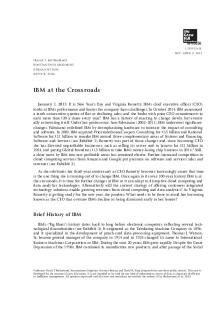Orbital apex injury: trauma at the junction between the face and the cranium PDF

| Title | Orbital apex injury: trauma at the junction between the face and the cranium |
|---|---|
| Author | Ken Linnau |
| Pages | 1 |
| File Size | 106 KB |
| File Type | |
| Total Downloads | 7 |
| Total Views | 84 |
Summary
Journal of Clinical Imaging 28 (2004) 153 – 155 Abstracts Diffusion-weighted imaging: basic concepts and application in cerebral Orbital apex injury: trauma at the junction between the face and stroke and head trauma the cranium Huisman TAGM (Department of Radiology, University Children’s Hospital L...
Description
Journal of Clinical Imaging 28 (2004) 153 – 155
Abstracts Diffusion-weighted imaging: basic concepts and application in cerebral stroke and head trauma Huisman TAGM (Department of Radiology, University Children’s Hospital Zurich, Steinwiestrasse 75, CH-8032 Zurich, Switzerland). Eur Radiol 2003; 13:2283 – 2297. Diffusion-weighted imaging (DWI) of the brain represents a new imaging technique that extends imaging from depiction of neuroanatomy to the level of function and physiology. DWI measures a fundamentally different physiological parameter compared with conventional MRI. Image contrast is related to differences in the diffusion rate of water molecules rather than to changes in total tissue water. DWI can reveal pathology in cases where conventional MRI remains unremarkable. DWI has proven to be highly sensitive in the early detection of acute cerebral ischemia and seems promising in the evaluation of traumatic brain injury. DWI can differentiate between lesions with decreased and increased diffusion. In addition, fulltensor DWI can evaluate the microscopic architecture of the brain, in particular white matter tracts, by measuring the degree and spatial distribution of anisotropic diffusion within the brain. This article reviews the basic concepts of DWI and its application in cerebral ischemia and traumatic brain injury.
Imaging of high-energy midfacial trauma: what the surgeon needs to know Linnau KF, Stanley RB, Jr., Hallam DK, Gross JA, Mann FA (F.A.M.: Department of Radiology, Harborview Medical Center, Box 359 728, 325 Ninth Avenue, Seattle, WA 98104-2499). Eur J Radio1 2003;48:17 – 32. Treatment goals in severe midfacial trauma are restoration of function and appearance. Restoration of function is directed at multiple organ systems, which support visual acuity, airway patency, mastication, lacrimation, smelling, tasting, hearing, and facial expression. Victims of blunt facial trauma expect to look the same after surgical treatment as before injury. Delicate soft tissues of the midface often make cosmetic reconstructive surgery technically challenging. Generally, clinical evaluation alone does not suffice to fully characterize facial fractures associated with extensive swelling, and the deeper midface is not accessible to physical examination. Properly performed computed tomography (CT) overcomes most limitations of presurgical examination. Thus, operative approaches and sequencing of surgical repair are guided by imaging information displayed by CT. Restoration of function and appearance relies on recreating normal maxillofacial skeletal anatomy, with particular attention to position of the malar eminences, mandibular condyles, vertical dimension and orbital morphology. Due to its pivotal role in surgical planning, CT scans obtained for the evaluation of severe midfacial trauma should be designed to easily depict the imaging information necessary for clinical decision making. Learning objectives: (1) understand the facial skeletal buttress system; (2) understand how the pattern of derangement of the buttress system determines the need for and choice of operative approach for repair of fractures in the middle third of the face; (3) understand the role and importance of CT and CT reformations in the detection and classification of the pattern of buttress system derangement.
0899-7071/04/$ – see front matter D 2004 Elsevier Inc. All rights reserved. doi:10.1016/S0899-7071(03)00295-X
Orbital apex injury: trauma at the junction between the face and the cranium Linnau KF, Hallam DK, Lomoshitz FM, Mann FA (F.A.M.: 325 Ninth Avenue, Box 359 728, Seattle, WA 98104-2499). Eur J Radiol 2003;48:5 – 16. Orbital apex injury is usually seen in multiply and severely injured patients who are subject to high-energy trauma. Orbital apex injury rarely occurs in isolation. By proximity, the face, the skull base, or their combination are the most likely regions to be injured in association with orbital apex trauma. The majority of these injuries occur as an extension of orbital, LeFort, nasoorbitoethmoid, panfacial, sphenoid, or temporal bone fractures of the skull. Complex osseous anatomic structures with intimately related multiple neurovascular organs make injuries to the orbital apex diagnostically and therapeutically challenging. Often other facial fractures extend into the orbital apex, or the orbital apex is damaged in conjunction with fractures of the skull base. Therefore, abnormal imaging findings within the orbital apex may be indicators of traumatic injury to the entire junctional zone of face and cranium.
Evaluation of breast microcalcifications according to breast imaging reporting and data system criteria and Le Gal’s classification Gu¨lsu¨n M, Demirkazik FB, Ariyu¯rek (F.B.D.: Department of Radiology, Faculty of Medicine, Hacettepe University, Sihhiye, 06100 Ankara, Turkey). Eur J Radiol 2003;47:227-231. Introduction/objective: Our aim was to evaluate the positive predictive value (PPV) of the analysis of breast microcalcifications according to breast imaging reporting and data system (BI-RADS) and Le Gal’s classification in identification of malignancy, and to assess the interobserver agreement using these criteria. Methods and material: Eighty-two patients with breast microcalcifications on their screening mammograms underwent surgical excision after a needle localization at our institution between July 1993 and June 2000. The mammograms were examined by two experienced mammographers retrospectively and independently. Each observer noted the morphology, distribution, associated findings, final assessment categories of microcalcifications according to BI-RADS criteria and the morphologic type of microcalcifications according to Le Gal’s classification. The PPVs for each radiologist and the interobserver agreement were determined by using these data and histologic findings. Results: Histopathologic results yielded malignancy in 25 (30%) cases. The evaluation of microcalcifications according to BI-RADS criteria revealed PPVs of 17% and 25% for category 4 lesions, and 68% and 44% for category 5 lesions. In the assessment of microcalcifications according to Le Gal’s classification, the PPV of type 4 lesions was 45% (for both observers), whereas the PPVs of type 5 lesions were 70% and 50%. The interobserver agreement was fair in evaluation of morphology of microcalcifications (k: 0.31), distribution of microcalcifications (k: 0.29), final assessment categories (k: 0.27) and moderate in evaluation of associated findings (k: 0.48) by using BI-RADS lexicon. It was higher for the assessment of milk of calcium and round microcalcifications than other typically benign microcalcifications, and for fine linear or fine linear branching microcalcifications...
Similar Free PDFs

The North Face
- 22 Pages

Analysis The North Face
- 4 Pages

The mechanisms of spinal injury
- 6 Pages

Comparison Between THE Texts
- 11 Pages

IBM at The Crossroads
- 22 Pages

Barbarians AT THE GATE
- 2 Pages
Popular Institutions
- Tinajero National High School - Annex
- Politeknik Caltex Riau
- Yokohama City University
- SGT University
- University of Al-Qadisiyah
- Divine Word College of Vigan
- Techniek College Rotterdam
- Universidade de Santiago
- Universiti Teknologi MARA Cawangan Johor Kampus Pasir Gudang
- Poltekkes Kemenkes Yogyakarta
- Baguio City National High School
- Colegio san marcos
- preparatoria uno
- Centro de Bachillerato Tecnológico Industrial y de Servicios No. 107
- Dalian Maritime University
- Quang Trung Secondary School
- Colegio Tecnológico en Informática
- Corporación Regional de Educación Superior
- Grupo CEDVA
- Dar Al Uloom University
- Centro de Estudios Preuniversitarios de la Universidad Nacional de Ingeniería
- 上智大学
- Aakash International School, Nuna Majara
- San Felipe Neri Catholic School
- Kang Chiao International School - New Taipei City
- Misamis Occidental National High School
- Institución Educativa Escuela Normal Juan Ladrilleros
- Kolehiyo ng Pantukan
- Batanes State College
- Instituto Continental
- Sekolah Menengah Kejuruan Kesehatan Kaltara (Tarakan)
- Colegio de La Inmaculada Concepcion - Cebu









